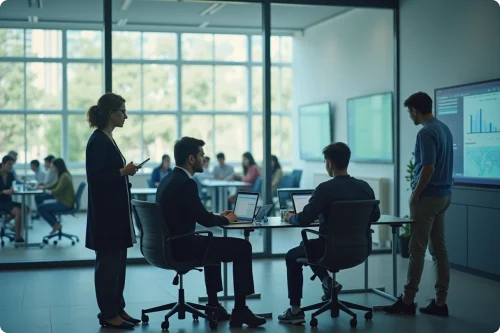Building Smarter Universities with the Best ERP for Universities and Research Bodies & LMS
Introduction
Universities and research bodies have always been the epicenter of knowledge creation and innovation. However, the demands of the 21st century are reshaping the way they operate. Students expect engaging digital learning experiences, researchers require seamless collaboration tools, and administrators must ensure transparency, compliance, and efficiency across all departments. To keep pace with these growing expectations, institutions are turning toward digital transformation. One of the most effective ways to achieve this is through ERP & LMS for Universities and Research Bodies. By merging enterprise resource planning (ERP) with learning management systems (LMS), universities can become “smart institutions” that are agile, data-driven, and globally competitive.
What Makes a University “Smart”?
A smart university is one that leverages technology to deliver education, manage operations, and foster research in a more efficient and impactful way. Unlike traditional systems, smart universities :
Automate administrative processes.
Provide personalized learning to students.
Enable digital collaboration for researchers.
Use analytics for decision-making.
Build stronger connections with industries and global partners.
Best ERP for Universities and Research Bodies acts as the digital backbone that makes all this possible.
Key Features of ERP & LMS in Building Smarter Universities
1. Digital Classrooms and Hybrid Learning
With LMS integration, universities can offer blended and fully online courses.Faculty can track engagement and provide timely feedback, making learning more inclusive and flexible.
2. AI-Powered Analytics
Modern ERP systems include predictive analytics that can forecast student success, identify resource gaps, and evaluate faculty performance. These insights help universities take proactive measures rather than reactive ones.
3. Research Management Tools
For research bodies, ERP modules track project milestones, funding utilization, and publication outcomes. Collaboration tools make it easy for researchers to work with international teams while maintaining data security.
4. Cloud-Based Accessibility
A smart university operates beyond physical boundaries. With cloud-based ERP & LMS, students, faculty, and researchers can securely access resources from any location, promoting global collaboration.
How ERP & LMS Transform Universities into Smart Institutions?
Enhanced Student Learning Experience
Students expect more than traditional lectures. With LMS tools like video lectures, quizzes, and discussion boards, learning becomes interactive. Personalized dashboards provide a clear view of progress, motivating students to perform better.Stronger Faculty Engagement
Faculty members benefit from workload management tools, digital attendance tracking, and automated grading. Instead of administrative overload, they can devote more time to teaching and mentoring students.Efficient Governance
Administrators gain real-time access to data across departments. Whether it’s financial records, research funding, or student performance, decision-making becomes faster and more informed.Boosting Research Excellence
Researchers can collaborate globally, track grants, and maintain compliance with funding agencies. ERP & LMS systems also make it easier to store and share publications, increasing visibility and impact.Sustainability and Cost Savings
Paperless processes, optimized resource utilization, and reduced administrative delays result in significant cost savings. Smart universities can reinvest these savings into infrastructure and innovation.
Advantages for Universities and Research Bodies
Improved Academic Delivery – Consistency and quality in course management.
Higher Research Productivity – Faster project completion and global recognition.
Increased Student Retention – Engaged learners are less likely to drop out.
Stronger Institutional Reputation – Efficiency and excellence boost global rankings.
Seamless Industry Partnerships – Universities can integrate with industries for internships, projects, and knowledge exchange.
Conclusion
Becoming a smart university is not a luxury—it is a necessity in the modern education landscape. By implementing ERP & LMS for Universities and Research Bodies, institutions gain the tools to modernize academics, strengthen research collaboration, and improve overall efficiency.
This transformation goes beyond digitization; it creates an ecosystem where students, faculty, researchers, and administrators thrive together. The result is a smarter, more sustainable, and globally competitive institution that is ready for the future of education.
For universities and research bodies seeking to lead in innovation, adopting ERP & LMS is the most impactful step toward building smarter, future-ready campuses.

